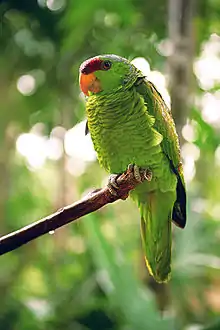Lilac-crowned amazon
The lilac-crowned amazon (Amazona finschi) is a parrot endemic to the Pacific slopes of Mexico. Also known as Finsch's amazon, it is characterized by green plumage, a maroon forehead, and violet-blue crown and neck.
| Lilac-crowned amazon | |
|---|---|
 | |
| At Xcaret Eco Park, Mexico | |
| Scientific classification | |
| Kingdom: | Animalia |
| Phylum: | Chordata |
| Class: | Aves |
| Order: | Psittaciformes |
| Family: | Psittacidae |
| Genus: | Amazona |
| Species: | A. finschi |
| Binomial name | |
| Amazona finschi (Sclater, 1864) | |
 | |
The binomial of this bird commemorates the German naturalist and explorer Otto Finsch.
In 2006, BirdLife International classified this species as vulnerable. In 2014, IUCN uplisted this species to Endangered.
Description

The plumage of an adult lilac-crowned amazon is primarily green with yellowish underparts and black edging.[2] The forehead is a maroon color with a light blue-lilac neck, nape, and crown.[2] The cheeks and ear coverts are a greenish yellow that lacks the edging that is present in most of the plumage.[2] The primary feathers are dark blue with the secondary feathers being green while being tipped with the same dark blue coloring.[2] Furthermore, the initial five secondary feathers have a bright red speculum on the edge of the feathers.[2] The wing coverts, underside of the flight feathers, and the tail are green while the tail is tipped with a yellowish coloring similar to that of the cheeks and ear coverts.[2] Their beak, orbital rings, and legs are a palebrown-grey coloring.[2] The irides of adult lilac-crowned parrots are amber colored.[2]
Juvenile lilac-crowned amazons are visually similar to their adult forms except for minor differences. One difference is that the iris of juveniles are a dark brown as opposed to the amber coloring that is found in adults.[2][3] The other major difference is that there less maroon colored feathers on the forehead of juveniles.[3] After about one year juveniles begin to acquire these adult features.[3]
Range and habitat
The lilac-crowned amazon's endemic range spans along the pacific coast of Mexico, beginning in southeastern Sonora and southwestern Chihuahua down to southern Oaxaca.[3] In Sinaloa and northern Nayarit the geographic range of the lilac-crowned parrot is above 375 meters of elevation and does not reach sea level until southern Nayarit, where it remains so through Jalisco and Oaxaca.[3][4]
The lilac-crowned amazon's natural habitat in Mexico is often threatened. Decline in population size has been recorded in almost all of its natural habitat locations.[4] Based on collection of data and resident accounts, Amazona finschi population range has decreased by 20% due to habitat loss.[5]
An increasingly growing population of approximately 100 individuals is found in Southern California especially in the San Gabriel Valley and Orange Country.[6] This increase could also be attributed to a more reliable source of measurement of population than in past years.[7] These populations often are found in residential areas and occasionally in nesting groups with red-crowned parrots in native conifer forests or non-native captive plants.[6]
Breeding
The lilac-crowned amazon's breeding season is from February to June.[2] They have a 28-day incubation period and a 60-day period of nestling growth.[8][2][9] They tend to nest in natural cavities of trees in dry forests.[8] Females have a clutch size ranging from 1-4 eggs which usually results in an average brood size of 1.8 nestlings and a reproductive output of 0.99 fledglings per egg-laying female.[10] Ultimately outcomes of reproductive efforts results in 0.70 independent young per egg-laying pair.[11]
These low success rates could be attributed to the climate variability in dry forests, which could have an effect on clutch size, reproductive output and success.[10][11]
Aviculture
Hand reared lilac-crowned amazons can be quite friendly in captivity and can learn quite a vocabulary, even though they are not known as talkers. They make good companion parrots.
References
- BirdLife International (2012). "Amazona finschi". IUCN Red List of Threatened Species. 2012. Retrieved 26 November 2013.CS1 maint: ref=harv (link)
- Forshaw, Joseph Michael; Cooper, William T. (1989). Parrots of the world (3rd ed.). London: Blandford. ISBN 0713721340. OCLC 19352622.
- Howell, Steve N. G.; Webb, Sophie (1995). A guide to the birds of Mexico and northern Central America. Oxford: Oxford University Press. ISBN 0198540132. OCLC 28799888.
- Renton, Katherine; Iñigo-Elias, Eduardo (2003). "Evaluation of the current status of lilac-crown parrot (Amazona finschi) populations in Mexico" (PDF). Unpublished Data – via CONABIO.
- Rios Muñoz (2002). "Caracterización geográfica de la familia Psittacidae (Aves) utilizando un modelo predictivo". Bachelors Thesis – via Facultad de Ciencias Universidad Nacional Autonoma de Mexico.
- Garret, Kimball (1997). "Population Status and Distribution of Naturalized Parrots in Southern California" (PDF). Western Birds. 28: 181–195.
- Mabb, Karen (2003). "Naturalized parrot roost flock characteristics and habitat utilization in a suburban area of Los Angeles County, California". Masters Dissertation – via California State Polytechnic University.
- Renton, K., and A. Salinas-Melgoza. 1999. Nesting behavior of the Lilac-crowned Parrot. Wilson Bulletin 111: 488-493.
- Renton, K. 2002. Influence of environmental variability on the growth of Lilac-crowned Parrot nestlings. Ibis 144: 331–339.
- Renton, K., and A. Salinas Melgoza. 2004. Climatic variability, nest predation, and reproductive output of Lilac-crowned Parrots (Amazona finschi) in tropical dry forest of western Mexico. Auk 121: 1214–1225.
- Salinas Melgoza, A., and K. Renton. 2007. Post-fledging survival and development of juvenile Lilac-crowned Parrots. Journal of Wildlife Management 71: 43–50.
External links
| Wikimedia Commons has media related to Amazona finschi. |
| Wikispecies has information related to Amazona finschi. |
- Overview of Amazona finschi from Neotropical birds.
- BirdLife species factsheet for Amazona finschi
- "Lilac-crowned amazon media". Internet Bird Collection.
- Lilac-crowned amazon photo gallery at VIREO (Drexel University)
- Interactive range map of Amazona finschi at IUCN Red List maps
- Audio recordings of Lilac-crowned amazon on Xeno-canto.

